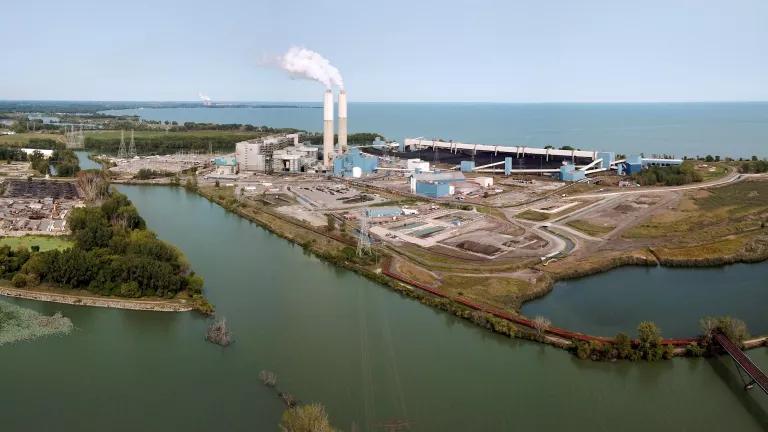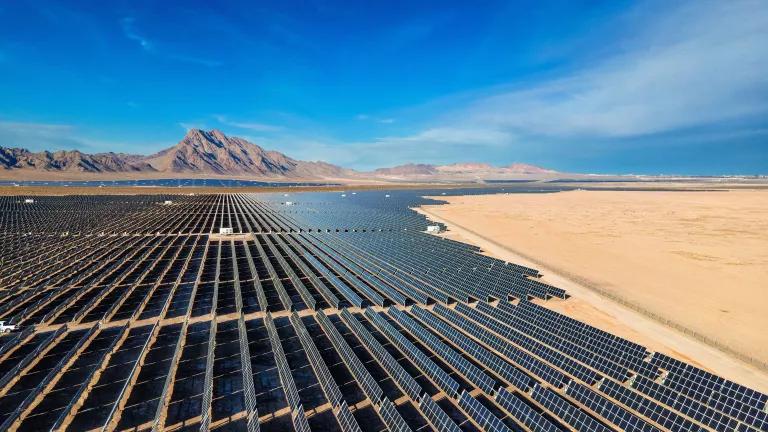NRDC each year reviews the most recent data to present an overall picture of the U.S. energy sector, which is undergoing a major shift toward increasing amounts of renewable energy and cost-effective energy efficiency. However, America still must do more to meet its share of our global climate goals.
2020
Slow and Steady Will Not Win the Climate Race
In 2019, America made steady progress in several crucial clean energy sectors. After a sharp uptick in 2018, total U.S. carbon pollution declined by 3 percent in 2019—driven primarily by the power sector, which also met the emissions-reduction goals of the Obama-era Clean Power Plan 11 years early. Wind and solar energy are thriving, and state laws, utility commitments, and corporate clean energy goals made in 2019 are poised to further accelerate the growth of renewable energy across the country. On the flip side, the United States continues to produce oil and gas in vast quantities; U.S. oil and gas consumption accounted for 80 percent of carbon emissions in 2019, and we export large amounts of these fossil fuels abroad, contributing to global emissions. This slow progress toward a clean energy future will simply not be enough to keep global warming to below 1.5 degrees Celsius and avert the worst impacts of the climate crisis. As we outline in our 8th Annual Energy Report, there is good news in our 2019 energy trends, but we must do more—much more—and we have no more time to waste.
View the 2020 Report
2019
America’s Energy Progress: Dueling Clean and Dirty Infrastructure
In the face of a hostile administration that has stalled national momentum (and even caused some backsliding), individual states, cities, utilities, and businesses are making groundbreaking commitments to meet the climate challenge. Solar and wind energy are thriving, and the costs of clean energy continue to fall rapidly. Wind and solar already outcompete coal power and are likely to put similar economic pressure on natural gas within the next decade and a half. Meanwhile, coal-fired generation has sunk to a four-decade low. Unfortunately, however, natural gas and oil infrastructure is expanding, incentivized by the influx of cheap fracked oil and gas. And, after five years of declining carbon dioxide (CO2) emissions, U.S. emissions ticked up in 2018; globally, CO2 emissions hit an all-time high. The U.S. must recommit to meeting our climate goals state by state and city by city while pushing for a return of federal support.
2018
America’s Climate Crossroads: Pushing Clean Energy Higher & Faster
Following another year of significant U.S. clean energy advances, the Intergovernmental Panel on Climate Change issued a sobering warning of dangerous impacts if we do not act quickly to limit global warming. This report explores emerging opportunities—and roadblocks—on the path to a safer climate future. Coal’s prominence fell to historic lows in 2017, with renewable energy and energy efficiency as the cleanest and cheapest U.S. energy sources. As a result, America nearly achieved the emissions reduction targets in the Clean Power Plan 13 years earlier than anticipated, despite a hostile Trump administration. And progress and innovation have unlocked cleaner, cheaper alternatives that are becoming mainstream resources across the nation. Even with these positive trends, much more must be done to ensure the clean energy transition continues.
2017
America’s Clean Energy Revolution
Despite new political headwinds, improved economics are propelling the clean energy revolution America needs, according to NRDC’s 2017 report. Dozens of clean energy records have been shattered across the United States. Solar energy has shown unprecedented growth and we now have our first U.S. offshore wind farm. Stronger energy efficiency investments and standards have slashed energy waste and utility bills. Meanwhile grid operators and utilities are working hard to integrate more clean energy into our electricity system without compromising reliability. All told, the United States is cutting climate-changing pollution even as national energy spending hits record lows.
2016
Accelerating Into a Clean Energy Future
The United States is building a clean energy revolution that will deliver deep pollution reductions, according to NRDC’s 2016 report. Coal-fired generation dropped to historic lows, producing only one-third of our electricity, while renewable energy generation reached record highs, with more than one-eighth of America's electricity generated from solar panels, wind turbines, and other renewable resources. The past year in energy saw a number of victories for the environment, highlighted by a global climate agreement and a carbon pollution reduction plan for the United States.
2015
A Tectonic Shift in America's Energy Landscape
The United States is leading a global clean energy transition that has reached new milestones, with coal and electricity consumption down nationwide, oil use flat, and renewable energy surging, according to NRDC's 2015 report. Sustained progress in energy efficiency, wind power, and solar generation paved the way for America's first nationwide limits on power plants' carbon pollution and offer hope for significant progress in the global climate negotiations scheduled for December in Paris.
2014
Positive Energy Trends Bode Well for U.S. Security and the Economy
The United States is reducing oil dependence, slowing the growth of electricity needs, and making energy services more affordable to all Americans. Oil and energy consumption remain well below levels seen a decade ago, renewable energy is surging, and growth in U.S. electricity sales continues to decline. NRDC's 2014 review shows that the overall state of the U.S. energy economy remains excellent. The most important single contributor to these positive trends is energy efficiency, the nation's largest and most inexpensive resource. Efficiency has allowed America to get more work out of less oil, natural gas, and electricity while pushing our economy forward. There is every indication that these positive energy trends will continue, and accelerate.
2013
America's (Amazingly) Good Energy News
For decades, America's energy news trended from bad to worse, beginning with the oil crises of the 1970s. However, NRDC's 2013 analysis found a remarkable turnaround. Based on key economic, security, and environmental indicators, the state of the U.S. energy economy has never been better. Due in large part to increased energy efficiency, positive energy trends are saving the nation hundreds of billions of dollars annually, helping U.S. workers and companies compete worldwide, making our country more energy-secure, and substantially reducing our national carbon footprint. However, these trends must continue and accelerate to offset the most damaging effects of climate change. We should build on America's positive energy trends, and give priority to efficiency improvements that cost far less than the energy they displace.
Downloads



